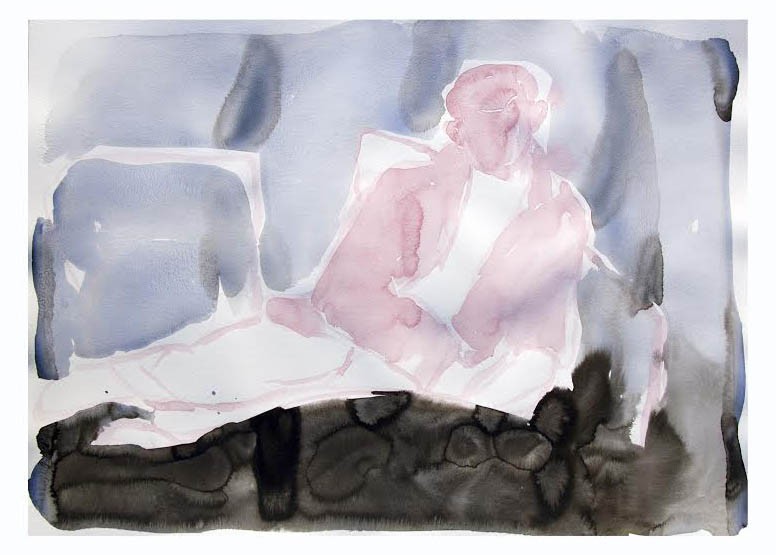
Posture and physiology speak of love, hurt, trauma, vulnerability and intimacy in Abdullah Qureshi’s work at Zahoor ul Akhlaq Gallery

Abdullah Qureshi’s exhibition, The Story of Myself and Some Friends in These Fragments of Daily Loves, consists of sixty works displayed in the two rooms of Zahoor ul Akhlaq Gallery at the National College of Art, Lahore. The first room of the exhibition consists of the large enamel paint-based portraits and echoes his earlier abstract works. The second room continues the display of enamel paint portraits of the first room but also adds water-colours on paper.
Enamel paint is a difficult medium to handle. It is hard to thin. Harder still to mix. When thickly-applied, it takes a long time to dry, and it is impossible to layer colours on top of one another. It also drips - as we all know from our experience of painting our walls. To use it as a medium for painting portraits is no easy task. Abdullah Qureshi’s work takes on this task with skill.
It might be worth asking at this point, why would an artist, then, use such a medium?
The answer lies in Qureshi’s development as an artist. His work, up to last year (that is three solo shows and ten group shows), has consisted mainly of large abstract works on canvas. Enamel paint, for such tasks, has an advantage. The colours are vivid, radiate energy and shine at the viewer; they are easy to apply with large rollers or large paint brushes and painting with the canvas flat on the floor Abdullah can cover large areas quickly and instinctively – as the best abstract painters have always done.
In these works too, the sensation of the colour is direct and distinct. Vivid, shining canvases with blocks of colour are likely to be most people’s first impressions of these. However, in this new body of work, figures - shown sitting down or standing - are added. These are placed in the centre of the canvas in medium shot, that is, full body or the waist upwards. The background consists of bright and uniform colours - pink, red, green, black and yellow (all of which have been thinned at times with white). In this ocean of enamel paint, our figures linger - suspended in time and space.
The viewer is asked to focus on two things: Firstly, the sensation of the colour; and secondly, on the physiology of the figures. What we are asked to experience is intimate and sensual. But less intellectual then, say if the figures were set in a historical location and interacted with objects. The figures, here, are drawn out sparely, without facial details - no noses, no mouths, no chins, and no eyes. What we do get is a sense of a hairstyle, outlined shape of a face, outer garments, and the outline of the pose and physiology of the figures. From this, and the titles of the work we can deduce that these are portraits of male figures. What could Abdullah possibly want us to read from this minimal data? That is, what is the physiological positioning of these figures on bright canvases telling us?
I want to suggest that Qureshi is inviting us to do what portraiture has always done so well, namely, to begin to cultivate in us an understanding of the ‘other’. Looked at closely, the pose of the figures reveals a certain vulnerability and therefore an intimacy. The shoulders are nearly always slumped, the muscles slightly relaxed but still largely tense, the hands of the figures seem to be reaching inside jacket or trouser pockets. They are hiding. They are nervous. These are vulnerable people, possibly scared and possibly heartbroken.
Whereas the enamel paint portraits are of a group of different men, in the watercolour-based works in the second room, one model dominates - Aziz. There is also a change of perspective. If the painted portraits are in medium shot then here Abdullah has taken the camera off the tripod - this is hand-held drawing. The watercolours portraits are intimate, sensual (both because the body is itself sensual but also because of the red/pink colour that is used to delineate it); the poses shift, so too does the framing, and the lines, while quickly drawn, are controlled.
These works remind me of a time I happened to be in love and the lover loved me even more. I recall her desire to document the intimacy with candid photos from around the house even in mundane routine. I felt harassed and flattered, loved and intimated. The watercolours, then, are a transposition of a most intimate love. They are its celebration and a celebration of the male body.
The viewing and painting of portraiture, among other things, is an ethical exercise. To understand another person, to take time to gaze at them on a canvas (as we could never do in real life), develops our ability to both read and sympathise with the other. Qureshi’s work in this exhibition is asking us to begin a conversation with a vulnerable group of men - to understand how posture and physiology can speak of love, hurt, trauma, vulnerability and intimacy. He is asking us to take our time, stand in front of these works, to study them and to begin to understand elements in the human make-up - that is, our relationships with each other, how our everyday life seeps into our bodies and posture, and finally with the watercolour-based works he asks us to celebrate the male body as intimate and sensual - worthy of love and itself desiring.